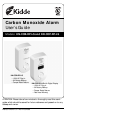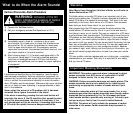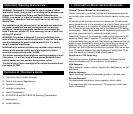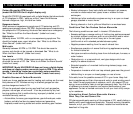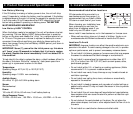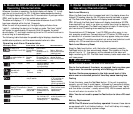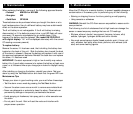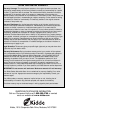
Recommended Installation Locations
CO alarms should be mounted in or
near bedrooms and living areas. It is
recommended that you install a Kidde
CO alarm on each level of your home.
When choosing your installation loca-
tions, make sure you can hear the
alarm from all sleeping areas. If you
install only one CO alarm in your
home, install it near bedrooms, not in the basement or furnace room.
• When wall mounting, place out of reach of children. Under no cir-
cumstances should children be allowed to handle the CO alarm.
Locations To Avoid
IMPORTANT: Improper location can affect the sensitive electronic com-
ponents in this alarm. T
o avoid causing damage to the unit, to provide
optimum performance, and to prevent unnecessary nuisance alarms:
• Do not install in kitchens, garages or furnace rooms that may expose
the sensor to substances that could damage or contaminate it.
• Do not install in areas where the temperature is colder than 40°F
(4.4°C) or hotter than 100°F (37.8°C) such as crawl spaces, attics,
porches and garages.
• Do not install within 5 ft. of heating or cooking appliances. (Kidde
recommends 15 ft. to prevent nuisance alarms).
• Do not install near vents, flues, chimneys or any forced/unforced air
ventilation openings.
• Do not install near ceiling fans, doors, windows or areas directly
exposed to the weather.
• Do not install in dead air spaces, such as peaks of vaulted ceilings or
gabled roofs, where CO may not reach the sensor in time to provide
early warning.
• Do not install this unit near deep-cell large batteries. Large batteries
have emissions that can cause the alarm to perform at less than opti-
mum performance.
• Do not obstruct the vents located on the alarm. Do not place the
alarm where drapes, furniture or other objects block the flow of air to
the vents.
• Do not install on a switched or dimmer-controlled outlet.
3. Installation Locations
Recommended Locations
2. Product Features and Specifications
Low Battery Warning
If the 9V battery is missing or battery power is low, the unit will chirp
every 15 seconds to indicate the battery must be replaced. If the battery
is depleted beyond the point of having the capacity to operate the unit,
it will chirp every 30 to 45 seconds and will NOT respond to the test
button being pressed if operating on battery power. THE BATTERY
MUST BE REPLACED IMMEDIA
TELY!
Low Battery HUSH
®
CONTROL
When the battery needs to be replaced, the unit will produce a low bat-
tery warning. The Low Battery HUSH
®
feature allows you to press the
button on the alarm and disable the “chirp” for a random period of up
to 12 hours. This gives you a chance to replace the battery at a more
convenient time without sacrificing your safety by disconnecting the
alarm from power. During this Low Battery HUSH® period, your alarm is
monitoring for CO.
IMPORTANT: Seven (7) years after the initial power up, this alarm
will “beep” every 30 seconds to indicate that it is time to r
eplace
the alarm. Replace the alarm immediately! It will not detect CO in
this condition.
To help identify the date to replace the alarm, a label has been affixed to
the side of the alarm. W
rite the “replace by” date (seven years from
power up) in a permanent marker on this label.
Temperature:
Operating Range: 40°F (4.4°C) to 100°F (37.8°C)
Humidity:
Operating range: 10-95% non-condensing
Audible Alarm:
85+ dB at 10’ @ 3.4±0.5 KHz pulsing alarm
Sensor:
Electrochemical
Power:
120 volts AC, 60 Hz, 60 mA max, 9 volt battery back-up
Alarm Response Times:
70 PPM = 60-240 min., 150 PPM = 10-50 min., 400 PPM = 4-15 min.



